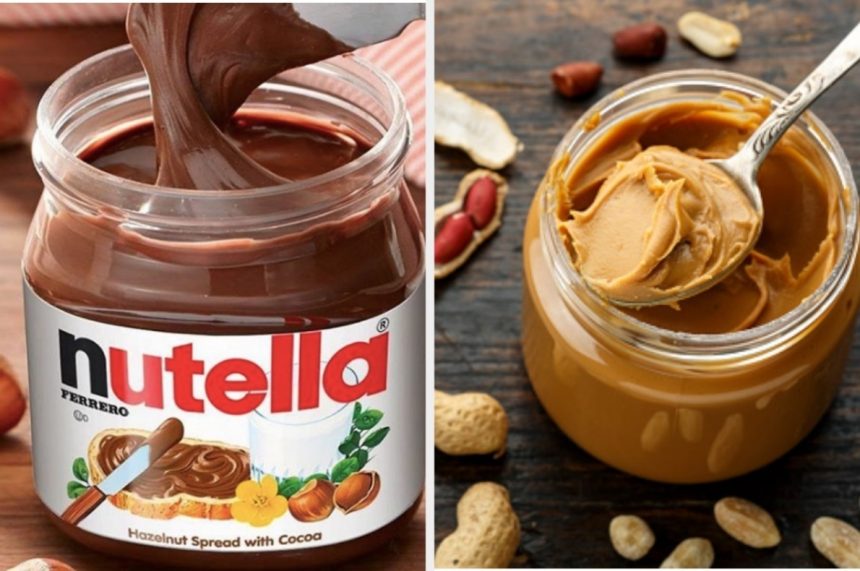Peanut Butter is compared to the well-known Italian hazelnut spread Nutella. Peanut Butter vs. Nutella which one is better a good for your health? To address this question, let’s examine the two goods’ component lists and nutritional information.

Exploring the Sweet World of Nutella
SUGAR, palm oil modification, hazelnuts, chocolate, decreased minerals in milk, and skim milk are listed as ingredients. Milk protein isolate (whey), soy lecithin (an emulsifier), and vanillin (an artificial flavor) are the three main ingredients. The lists of ingredients are ordered such that the item used in the greatest amount is listed first. As a result, you would think that Nutella is nothing more than a sugary spread. Where does palm oil now stand? Palm oil, a popular cooking oil, has one of the highest percentages of saturated fats and has been related to elevated LDL cholesterol and an increased risk of cardiovascular disease of any vegetable oil.
Discovering the Creamy Goodness of Peanut Butter
The label states that it contains roasted peanuts, maize maltodextrin, sugar, soybean oil, hydrogenated vegetable oil, and salt. Peanuts are a fantastic food choice since they include both protein and unsaturated fats. Maltodextrin is used in the food industry to improve both the product’s shelf life and its texture in the mouth.
Maltodextrin is a common sweetener found in many treats and drinks. Sugar comes next, and then soybean oil, which is high in polyunsaturated fats from plants and may help bring down “bad” cholesterol levels. Hydrogenated vegetable oil is the next ingredient, and it’s not good for your heart since the hydrogenation process stabilizes the lipids to extend the product’s shelf life. Hydrogenated oils have been associated with an increase in LDL cholesterol and the risk of cardiovascular disease.
Spread Showdown: Peanut Butter vs. Nutella Ingredients
The Dietary and Textural Qualities
Nutella and creamy peanut butter have very similar consistency. Each is easily spreadable and thick. Nonetheless, their nutritional values are relatively distinct from one another. Depending on whether you get the name brand or a retail brand, Nutella contains around two hundred calories per two tablespoons, whereas peanut butter has between 180 and 210 calories per two tablespoons, depending on the brand.
Tasting the Difference
The delightful hazelnut spread and peanut butter have contrasting flavors. Nutella has a taste consisting of hazelnut and chocolate, unlike peanut butter, which has a peanut taste combined with sweet and savory characteristics that are unique to peanut butter alone.
3 Unique Uses
Both peanut butter and Nutella may be used in comparable ways. They are used most often as a topping for toast, pancakes, and waffles. Peanut butter is also used in baking, although Nutella is not often seen in baked products, although there is no reason why it might not be.
Peanut Butter vs. Nutella: A Nutritional Comparison
Comparing the constituents of two food items is an effective technique to determine their real distinctions. Nutella’s primary component is sugar, as opposed to peanut butter, whose primary ingredient is roasted peanuts, followed by sugar.
Both spreads include oil, which is often palm oil in the case of Nutella, and peanut oil in the case of most brands of peanut butter. Nutella contains hazelnuts in addition to milk products and cocoa powder, none of which are present in peanut butter.
Peanut butter is a simpler product in terms of components, albeit it often contains salt for flavoring, while Nutella does not.
Peanut Butter vs. Nutella Nutrient Comparison
The comparison will be made on a weight-for-weight basis using 100g of each product and 15g per serving, which is about one tablespoon of spread. The components of the Nutella brand spread are listed in the table below, while peanut butter ingredients are typical of most brands but might vary.
Sugar: Nutella has far more sugar per serving than peanut butter, with 8g per 15g compared to 1.6g per 15g in peanut butter. This indicates that Nutella has more than 50 percent sugar per serving, making peanut butter the superior alternative.
Calorie: Weight-for-weight Nutella and peanut butter are both high-calorie foods due to the presence of nuts, oil, and sugar. Peanut butter is often higher in calories than Nutella, with 9kcal more per 15g of spread.
Carbohydrate: There is a significant difference in the carbohydrate content of Nutella and peanut butter, with peanut butter containing 3.3g of carbohydrates per 15g compared to Nutella’s 9.4g per serving.
Protein: Peanut butter is also superior to Nutella in terms of protein content, with 2.6g more protein per 15g serving than Nutella.
Fiber: Neither Nutella nor peanut butter is very rich in dietary fiber, but in this comparison, Nutella has a little greater fiber content per serving.
Vitamins: Nutella and peanut butter both include a number of vitamins and minerals derived from the nuts and other natural ingredients they contain. Comparing the two types of spread, peanut butter includes more vitamins and minerals than Nutella in the majority of nutritional categories.
Flavor: Since Nutella and peanut butter taste so differently, it is difficult to determine which has the greatest flavor; thus, it relies on personal choice.
Cost Factor
The price difference between peanut butter and Nutella is quite noticeable as well. When compared on an ounce-for-ounce basis, the cost of Nutella is much more expensive. As compared to the price of peanut butter per ounce, the price of Nutella per ounce might be up to two times more in certain retail locations.
Final thoughts Peanut Butter vs. Nutella
Butter vs. Nutella: Which One Is Better Completely Depends on Your Taste Birds But We Hope That the Information Presented Here Will Help You Narrow Down Your Options In the end, the choice comes down to a matter of preference, and whether or not Nutella or butter is better depends entirely on your personal preferences.
About Author: The content is written by Shagufta. She has been writing health articles for the past six years.














